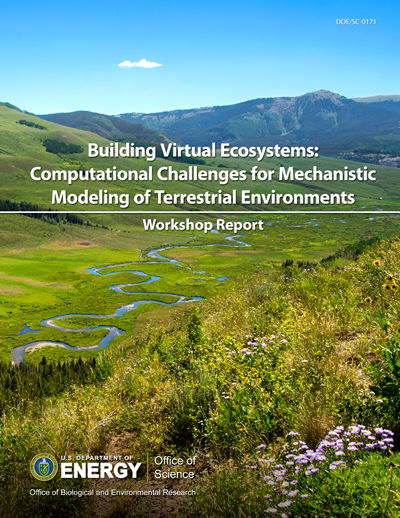Building Virtual Ecosystems: Computational Challenges for Mechanistic Modeling of Terrestrial Environments Workshop Report
- Print Publication: February 2015
- Workshop Dates: March 26–27, 2014
- Report Download: Fast-download PDF
- Report Download: Print-quality PDF
- Executive Summary: Print-quality PDF
To explore the potential of a new generation of multiscale, multiphysics models for revolutionizing the understanding of terrestrial ecosystem dynamics, Office of Biological and Environmental Research (BER) held the Computational Challenges for Mechanistic Modeling of Terrestrial Environments workshop on March 26–27, 2014, in Germantown, Maryland.
Three broad scientific challenges were identified. At the scale of individual plants, a more robust, predictive capability requires greater focus on integrating, at the whole-organism level, the rapidly developing mechanistic understanding of plant growth, form, function, and interactions with the surrounding biotic and abiotic environment in the soil and rhizosphere. At the scale of catchments and watersheds, the central challenge is to develop high-resolution watershed-scale models of the hydrological, carbon, and nutrient cycles with tractable representations of the integrated vegetation-hydrological-biogeochemical systems. Cutting across the disparate spatial and temporal scales is the third challenge of improving models for biogeochemical cycling, including more realistic descriptions of microbiological communities and their function and better representations of the effects of small-scale processes and heterogeneities at field scales. These three individual challenges are interlinked, emphasizing the multiscale, interdisciplinary nature of the overarching challenge.
To meet these three challenges, three research opportunities were identified: (1) a virtual plant-soil model that combines mechanistic models of plant growth, form, and function with high-resolution models of hydrological and biogeochemical processes in the surrounding soil and rhizosphere; (2) a virtual plot model that combines multiple virtual plants or parameterizations of individual plants with detailed representations of belowground processes; and (3) a virtual watershed model that tracks fluxes and storage of water, energy, carbon, and nutrients on the surface and in a three-dimensional subsurface.
Suggested Citation: U.S. DOE. 2015. Building Virtual Ecosystems: Computational Challenges for Mechanistic Modeling of Terrestrial Environments: Workshop Report, DOE/SC-0171. U.S. Department of Energy Office of Science. https://ess.science.energy.gov/virtual-ecosystems-workshop.

